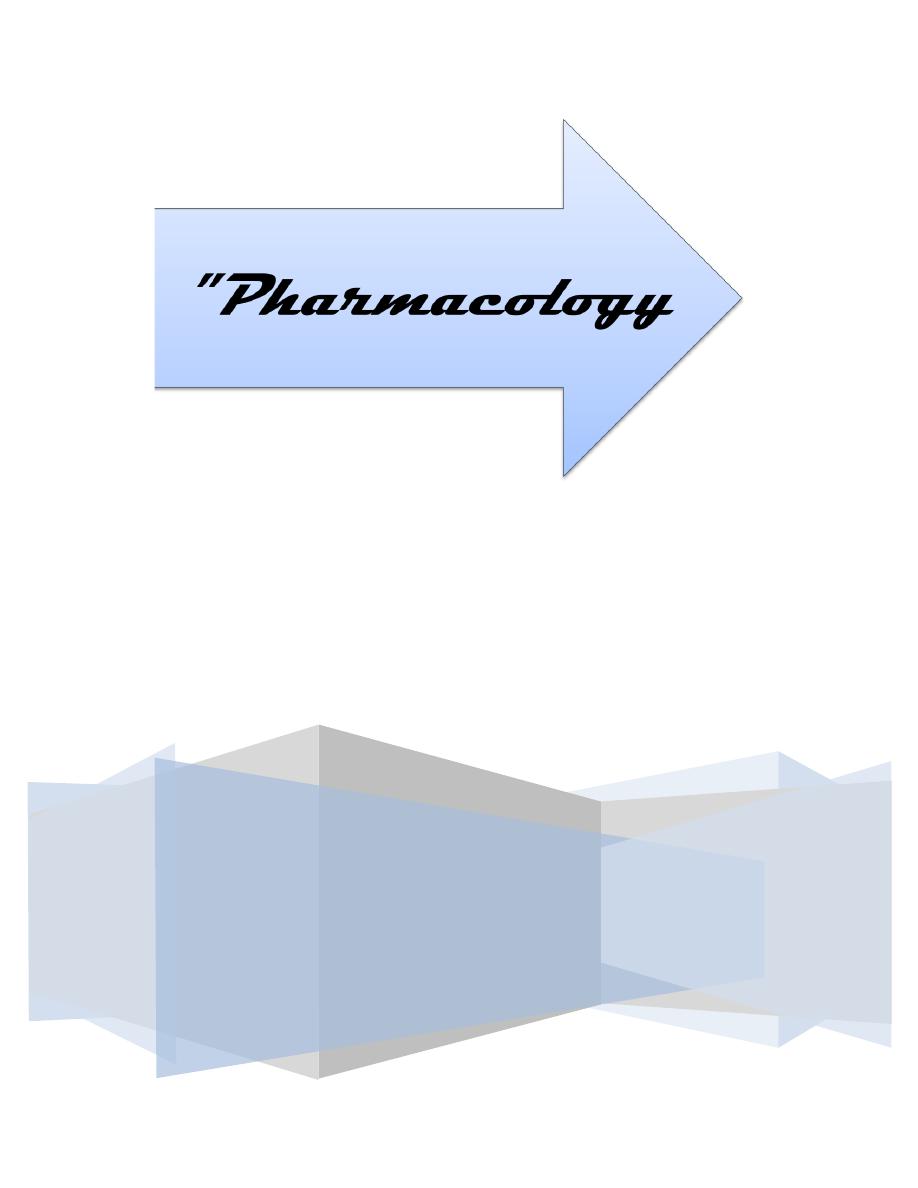
Sunday 29 / 3 / 2015
©Ali Kareem 2014-2015
Name
:
______________________________
Class
:
_______________________________
مكتب اشور لالستنساخ
DRUGS USED IN GIT
Lecture 9
Total lectures NO. 50
Dr. Samer Matloub

Drugs used in GIT
REFLUX ESOPHAGITIS:
It is a condition in which the acid is regurgitated from stomach to lower esophagus
because of lowering of the sphincteric tone and frequent relaxation of the lower
esophageal sphincter more than normal. This condition causes what's called" heart burn"
Esophageal injury may be managed as the following:
A. General measures:
include advise to avoid the following:
Meals late at night or lying down after meals.
Heavy Lifting, bending.
Being overweight.
Smoking.
Substances that aggravates the condition e.g. Alcohol, fat and chocolate.
Drugs as nitrates, calcium channels blockers & theophylline.
B. Drugs:
1. We can use antacids alone or in combination with alginic acid as "Gaviscon" to
produce a floating viscous gel that blocks the reflux.
2. In more severe cases, it requires H2- receptor antagonist in a dose higher than that
used for duodenal ulcer or gastric ulcer and for longer period of time (probably
more than 8 weeks).
3. Still better if we use the proton pump inhibitors e.g. omeprazole.
4. Prokinetic drugs like: metoclopromide, cisapride, are useful in reflux esophagitis,
sometimes a combination of these drugs with an antacid or proton pump inhibitor is
used.
5. We don't need eradication of H.pylori because they are not the etiological cause.

ANTI-EMETIC DRUGS & PROKINETIC DRUGS:
The vomiting center in the medulla {which is rich in muscarinic, H 1& 5HT3 } receptors
does not initiate but rather coordinates the act of emesis on receiving stimuli from various
sources:
1. CTZ {chemoreceptor trigger. zone}: rich in D2, 5HT3,NK1 & opioid receptors can
be blocked by: phenothiazine, buterophenone, metoclopromide , ondansetron.and
aprepitant,fosaprepitant(both are NK1 antagonists)
2. The vestibular system: via the 8
th
cranial nerve rich in muscarinic & H1 receptors
(in motion sickness).
3. The periphery: e.g. distention or irritation of the gut, M.I., biliary or renal colic.
4. Cortical centers: due to psychiatric disorders stress,bad smell anticeptory vomiting.
5. Irritation of the pharynx {gag reflux}.
5HT3 receptors are also involved in the emesis probably by central and peripheral
mechanisms; they are blocked by odansetron (an effective 5HT3antagonist).
Antiemetic drugs acting on the vomiting center have anti-muscarinic action, e.g.
hyoscine, promethazine, cyclizine, the last two are also H1. receptor blockers.
Antiemetic drugs acting on CTZ are effective for vomiting induced by morphine,
digoxin, cytotoxics, and uremia.
Antiemetic drug having more than one site of action have more efficacy.
DRUGS STIMULATING GIT MOTILITY I.E. DRUGS THAT SELECTIVELY
STIMULATE THE GUT MOTOR FUNCITON (PROKINETIC DRUGS):
These drugs promote the release of Ach from the myenteric plexus of the gut, those
include D2 receptor antagonists (metoclopromide, dompridone), 5H4 agonists (cispride),
they have one or more of the following actions:
1- Increase lower esophageal sphenicteric tone, may be useful for GERD.
2- Increase the rate of gastric emptying, used for gastroparesis and postsurgical emptying
delay.
3- Increase peristalsis through intestine up to ileocecal valve, used for post operative ileus
& chronic intestinal pseudo -obstruction.

Cholinomimetics (bethanicol) acting on M3 receptors and neostigmine
{anticholinesterase) were used as prokinetic in the past (less frequently used now
days).
4- Some drugs have effect on colonic motility nay be useful in IBS (irritable bowel
syndrome) and chronic constipation. e.g. tegaserod (a patial5HT4 agonist).
All the above effects are called prokinetic effects. Other agents in the category include
motilin (acts on motilin receptor) which stimulates gastric emptying and post prandial
gastric contraction (marcolide Abcs e.g. erythromycin; is a motilin like drug).
Note: not every anti-emetic is a prokinetic and not every prokinetic is an ant-iemetic. So,
some drugs act peripherally while others act centrally and some may work on both
(metoclopromide).
Drugs for nausea & vomiting:
Metoclopromide (plasil,meclodin):
This drug acts by blocking D2-receptors. Centrally on CTZ and also peripherally by
enhancing the action of Ach on myenteric nerve ending in the gut (raises the tone of the
lower esophageal sphincter, stimulates peristalsis and also increases the emptying of the
upper gut) (prokinetic action). * At higher dose it also blocks 5HT3 receptors.
The direct effects on the gut are antagonized by antimuscarinic drugs, it is metabolized by
the liver t1/2 = 4hrs.
Uses:
1. Nausea & vomiting associated with GIT disorders.
2. Nausea & vomiting produced by cytotoxic drugs and radiotherapy.
3. Effective anti-emetic in migraine.
4. Nausea & vomiting after surgery and diabetic gastroparesis
5. As a prokinetic agent to empty the stomach before emergency surgery and labor
(decrease aspiration)
6. Used in GERD.
7. Non ulcer dyspepsia

Side effects:
Metoclopromide is an antagonist at D2-receptor, this action causes extra-pyramidal side
effects that can be abolished by benztropine I. V., and these side effects may include:
a- Torticollis, facial spasm, trismus and oculogyric crisis.
b- Long term use may cause tradive dyskinesia in elderly patients.
c- It stimulates prolactin release leading to gynecomastia (in males), galactorrhea and
sexual disturbances (in females).
d- It may cause motor restlessness and probably diarrhea.
Dompridone:
T1/2=7hrs, it blocks D2-receptot in CTZ and peripherally in the gut, it has little central .
side effect since it poorly crosses BBB; it may cause galactorrhea & gynecomastia.
Cispride:
T1/2= 10hrs. structurally related to metoclopromide but has no effect on D2receptors. It
has 5HT4-receptor agonist activity and some antagonistic activity on 5HT3-receptor .
It acts only peripherally by increasing Ach. release in the gut/ so it is only
prokinetic.
Its effect is terminated by metabolism and it undergoes significant 1st pass hepatic
metabolism effect when taken orally.
Uses:
a- Reflux esophagitis.
b- When the gastric motility is impaired as in diabetes mellitus and systemic sclerosis.
Another partial 5HT4-receptor agonist is tegaserod. It is approved for use in IBS with
predominant constipation.
Drug interactions:
Serious cardiac arrhythmia may occur when taken with macrolides antibiotics as
erythromycin and clarithromvcin, and antifungal drugs as ketoconazole & miconazole,
and because of these interactions this dug is no more used.

Side effects:
1- Abdominal cramping.
2- Diarrhea.
Selective 5HT3-receptor antagonists
: Ondansetron, Granisteron, Tropisetron,
Dolasetron and palonsetron:
They are highly effective for treatment of nausea and vomiting induced by cytotoxics and
radiotherapy. T1/2=4-9 hrs. given orally or I. V. once daily. Polansetron is a newer I. V.
agent with t1/2= 40 hrs.
Mechanism of action:
They have anti-emetic properties that are mediated mainly through 5HT3-receptor
blocking on intestinal vagal afferents. This is in addition to central 5HT3 blockade at the
vomiting center and CTZ.
Anti-cancer treatment releases serotonin from enterochromaffin cells in the gut and this
serotonin activate specific receptors in the gut and CNS to initiate vomiting so blocking
5HT3-receptors will control vomiting, so these drugs are given before the
chemotherapeutic agents to control vomiting. These drugs do not inhibit dopamine or
muscarinic receptors and have no effects on esophageal or gastric motility but may slow
colonic transit.
Side effects:
1- Constipation.
2- Headache.
3- Feeling of flushing.
Alosteron is another 5HT3 antagonist is approved for the treatment of IBS predominant
diarrhea and it is not used for vomiting.

Nabilone and Dronabinol:
Synthetic canabinoids related to marijuana, they are used to relieve nausea & vomiting
caused by cytotoxics, the mechanism is unknown.
Side effects:
1- Somnolence.
2- Dry mouth.
3- Decrease in the appetite.
4- Postural hypotension.
5- Psychosis.
These side effects may be decreased when prochlorperazine is given concomitantly.
Other anti-emetics:
1- Dexamethasone: used to relieve vomiting due to cytotoxics. Probably it acts by
inhibiting prostaglandins in the brain.
2- Benzodiazepine: like lorazepam and aprazolam, they act by producing amnesia; they
are used prior to chemotherapy to reduce anticeptory vomiting and vomiting caused by
anxiety.
Often when we treat patient from vomiting due to cytotoxic therapy, we combine several
drugs to increase the antiemetic effects e.g. dexamethasone + ondansetron (best
combination).
3- Phenothiazine: like promethazine, chlorpromazine and prochlorperazine (D2).
4- Butyrophenones: e.g. haloperidol, droperidol (D2)
5- H1 anti-histamines and anti-cholenergics:
Anti-histamines like e.g. diphenhydramine, meclizine.
Anti-cholinergics like e.q. hyoscine.
6-NK1 antagonists these are new, used in cancer chemotherapy induced vomiting in
combination with 5HT3antagonist and dexamethasone

DIARRHEA
Drugs used for treatment of diarrhea can be classified into:
1. Drugs that increase the viscosity of the gut content directly, these are adsorbants
that act by coating the bowel and by adsorbing toxic substanes (e.g. kaolin a
naturally occurring hydrated MgAl Silicate) and pectin(indigestible CHO derived
from apples)] these drugs are weak and usually used in children, their therapeutic
efficacy is marginal.
2. Drugs that delay the passage of the gut contents i.e.anti-motility drugs (opioid
agonists) e.g. codeine, diphenoxylate and loperamide. They act on the bowel
leading to decrease peristalsis allowing more time for water to be absorbed they
decrease mass colonic movement and the gastrocolic reflex.
a- Codeine:
It activates opioid receptors on the smooth muscles of the bowel leading to
decrease peristalsis and increase segmentation contraction, so the passage is delayed; it is
best avoided in patients with diverticular disease and in cases of increased intracolonic
pressure.
Side effects include tolerance and rarely dependence.
b- Diphenoxylate:
T1/2=3hrs. / it is structurally related to pethidine and affects the bowel as morphine. It is
used is small dose mixed with trivial dose of atropine to discourage abuse so as to give
signs when toxic dose is taken also the anticholinergic action of atropine may contribute
to its anti-diarrheal action. It's also used to control colostomies .. It crosses the BBB.
Side effects:
1. Nausea & vomiting.
2. Abdominal cramps.
3. Depression of the CNS.
4. Depression of respiration even after 16 hrs. because of delayed gastric emptying.
5. In babies it may cause paralytic ileus.

c- Loperamide:
T1/2=10hrs. , it is structurally similar to diphenoxylate, it impairs propulsion of gut
contents by affecting the circular and longitudinal muscles of the gut partly due to its
action on opioid receptor. It is a non prescription opioid agonist (OTC) that doesn't cross
the BBB and has no potential for addiction.
Side effects:
a- Nausea & vomiting.
b- Abdominal cramps.
Notes:
1- The action of anti-motility drugs can be antagonized by naloxone.
2- They should not be given to babies because they cause respiratory depression and
paralytic ileus.
3- The best treatment of diarrhea in children is the oral dehydration solution (ORS)
3} Colloidal bismuth compounds (discussed before)
4} Bile salts binding resins (cholestyramine and colestipol) used for colonic secretory
diarrhea due to malabsorption of bile salts due to disease in the terminal ileum e.g. crohn's
disease & resection.
5} Octereotide (synthetic somatostatin) inhibits intestinal secretion and intestinal
motility, used for diarrhea due to vagotomy,dumping syndrome or short bowel syndrome.

CONSTIPATION
Drugs used for treatment of constipation are called purgatives,cathartics, laxatives,
aperients, or evacuants.
They are classified into:
a- Bulk.
b- Osmotic.
c- Fecal softeners.
d- Stimulants.
e- Chloride channel activator(lubiprostone)
f- Opioid receptor antagonists selective for mu receptors in the
intestine(methylnaltrexone, alvimopan)
g- 5HT4 receptor agonists (e.g. tegaserod,cisapride,prucalopride) for chronic
constipation & IBS.
a-
Bulk purgatives: these are indigestible fibers & hydrophilic colloids that absorb water &
act by increasing the volume of the intestinal contents to promote a large soft stool, i.e. they
encourage normal reflux bowel activity & they are also helpful in :
1- Diverticular disease.
2- Anal fissure & hemorrhoids.
3- Irritable bowel syndrome (IBS).
They act within 1-3 hrs. & should be taken with a large amounts of fluids, otherwise
they may cause intestinal obstruction.
Dietary fibers are essentially the cell wall of the plant cells (CHO as cellulose &
hemicelluloses & non CHO as lignin).
Medically, fibers have 2 notable properties: 1) they are not broken down by enzymes
of the gut, so they enter the colon intact. 2) They have a vast capacity of retaining
water e.g. 1 gm of carrot fibers can hold as much as 23 gms of water.
Bran eating is a natural way of treating constipation, it contains (25-50%) of fibers, it
is the residue left when flour is made.
Common preparations include:- methyl cellulose & psyllium and
ispogula husk (like bran) also absorbs water, contains mucilage & hemicelluloses
which rapidly swells with water.
b-
Osmotic laxatives:
These are little absorbed, they the bulk & the viscosity of the intestinal contents
leading to fluid stool, these are used for acute & chronic constipation, they include:
1- Mg
++
salts: Mg (OH)
2
, MgSO
4
(Epsom salts), they act in 2-4hrs. but frequent use can
cause Mg
++
poisoning especially if there is renal impairment.

2- Lactulose: used for chronic constipation, a synthetic diasaccharide unaffected by the
intestinal diasaccharidases, when taken orally( so it's not absorbed). It acts as an osmotic
laxative but takes about 48 hrs. to produce its action.
In the colon it is fermented into lactic acid & acetic acid which interfere with the growth of
ammonia producing organisms & lowers the PH of the colon, therefore, decreasing the
non-ionic diffusion of ammonia from the colon.lt is used therefore in the management of
hepatic encephalopathy. It is also used for distal ulcerative colitis in which there is stasis of
the feces in the proximal colon.
3- Sorbitol
4- Balanced polyethylene glycol (PEG): contains an osmotically active nonabsorbable
sugar, it's used as lavage solution for complete colon cleansing prior to endoscopic
procedures, & in small doses for chronic constipation unlike sorbitol or lactulose , it does
not cause cramps or flatulence.
c-
Fecal softeners:
the softening properties of these agents make them useful for anal fissures & piles
(hemorrhoids), these agents soften stool by permitting water and lipids to penetrate, and
they are adminisered orally or rectally.
1. docusate Na+: softens stool by lowering surface tension of fluids in the intestine
which allow more water to remain in feces & also has a bowel stimulant action. It's
relatively weak laxative that act in 1-2 days.
2. poloxamers: act similarly & used in combination with other agents.
3. Liquid paraffin: inert mineral oil not digested. It reduces water absorption in the
small intestine plus the softening powers of the oil.
It's usually presented as an emulsion combined with Mg (OH) 2
Disadvantages: it may cause paraffinoma as it's absorbed into the mesenteric lymph nodes.
It can also cause physical as well as social discomfort when taken in large doses because it
may leak out of the anus, also if it is taken over a long period of time especially at night, it
may be aspirated & causes chronic lipid pneumonia.
4. Arachis oil: included in enemas to soften impacted feces.
d-
Stimulant purgatives
They increase the intestinal motility by various mechanisms, they can also cause cramps &
should not be used in patients with suspected intestinal obstruction.
1. Diphenylmethane dervivatives (Bisacodyl, Phenolphthalin) Bisacodyl
stimulate the sensory nerve endings in the colon by direct action from the lumen.
It's effective orally in 6-10 hrs. & as a suppository it acts in 1 hr.
Phenolphthalin : it is no more use because it may cause rashes and the duration
of action is prolonged.
.

2. Anthraquinone group(senna, cascara, aloe) in the small intestine, soluble
anthraquinone is liberated & absorbed & then re-excreted in the colon to exert their
effect.
Disadvantages: they cause change in the color of urine, which become brown in the acidic
PH & red in the alkaline PH, also they cause melanosis of the colon. Danthron : it's
carcinogenic in animal & best to be avoided.
Senna: widely used for constipation before diagnostic procedures & surgery, it acts
within 8-12 hrs.
3. Caster oil: it's hydrolyzed in the small intestine to (ricinoleic acid) which initiates
peristalsis & reduces absorption, resulting in a fluid stool, it acts within 2-6 hrs., it
has very irritant & powerful action (enough to start labour in pregnant woman), it's
seldom used nowadays.
4. Glycerol: it has a mild stimulant effect on the rectum, used as a suppository
usually for children
e-
Chloride channel activator(lubiprostone) stimulate type 2 chloride channels
in the small intestine,used for chronic constipation and for IBS with
predominant constipation
f-
Opioid receptor antagonists selective for mu receptors in the
intestine(methylnaltrexone, alvimopan) used for constipation in patients who
receive morphine for palliative care. Alvimopan is used to shorten the duration
of postoperative ileus.
g-
Serotonin 5HT4 receptor agonists
Notes:
1. All laxatives are liable to misuse leading to emotional and physical dependence.
2. Chronic use may cause:
a. Malabsorption.
b. Protein losing enteropathy
c. Damage to the nerves
d. Atony of the colon
e. Hypokalemia
3. The should not be used for patients with undiagnosed abdominal pain or when we
suspect intestinal obstruction
INTESTINAL SPASM
Drugs used for the treatment of intestinal spasm include:
a) Antimuscarinic drugs: they are given to patients with simple intestinal cholic, e.g.
atropine, scopolamine, propantheline.

b) Others:
1. Mebeverine: a reserpine derivative used for patients with IBS without the troubling
side effects of antimuscarinic drugs, it acts directly on the gut (direct effect on
colonic muscle activity, it's not an antimuscarinic drug)
2. Alverine & peppermint: they have the same direct smooth muscle relaxing action
maybe used for IBS
CHORIONIC INFLAMMATORY BOWEL DISEASE (IBD)
Includes: ulcerative colitis and Crohn's disease drugs for treatment include:
A- Corticosteroids:
Used for active disease, not for maintaining remission of the disease, so it does not prevent
relapse .
IV. steroids: e.g. hydrocortisone and methylprednisolone .
Oral steroids: e.g. prednisolone .
Topical steroids: for distal disease e.g. betamethasone, prednisolone phosphate,
hydrocortisone .
Steroids with low systemic bioavailabilty (used topically or orally), they are rapidly
metabolized first pass steroids, e.g. budesomide, toxicortol, beclomethasone, and
fluticasone. They produce fewer side effects than the other conventional steroids.
B- Aminosalicylates:
These are less effective than steroids for the active disease (may be used for mild-moderate
active disease), but their principle use is to maintain remission.
Sulphsalazine: it consists of two compounds (sulphpyridine and 5 amino salicylic acid)
joined by azo bond. This bond is broken by the action of bacteria in the colon into the
component compounds.
5-amino salicylic acid is the active compound while the Sulphpyridine is only for delivery
of the drug to the colon (carrier molecule)
. sulphapyridine is absorbed and acetylated in the liver and excerted in the urine; it has no
therapeutic action but causes adverse effects.
Mechanism of action: the 5-AsA confers the anti-inflammatory activity, where it can
affect multiple sites in the archidonic acid pathway. GH synthetase is inhibited as well as
leukotriene formation. It may have ROM scavenging activity. Also it may interfere with the
production of inflammatory cytokines. However, the exact mechanism is not known.
Side effects: headache, nausea and vomiting, anorexia (dose related), fever, leucopenia,
oligospermia (reversible) lymphadenitis and agranulocytosis.
Because of the frequent side effects and intolerance to sulphasalazine, other compounds
which contain 5ASA has been developed.
The problem was how to deliver 5ASA to the small intestine and proximal colon, because
5-ASA is rapidly absorbed from the jejunum, several principles has been used for this
purpose:

1- Coating 5-AsA with a resin or semipermeable membrane that is PH sensitive or time
release, the preparation developed is called mesalamine or mesalazine, these are delayed
release preparations of 5-AsA.
2- Linking 2 (5-ASAjs by an azo bond and the compound is called olsalazine that is splitted
by colonic bacteria or linking 5AsA to a molecule that is less toxic than sulphapyridine .
• Balsalzide: is produced by linking 5AsA to a less toxic molecule than sulphapyridine,
e.g. 4-aminobenzoyl- alanine .
• Ibsalazide: linking 5-AsA to 4-aminobenzoyl- glycine.
3- Using enemas or foam preparation (the direct application of 5ASA to the left colon).
C- Immuno-suppressive drugs:
E.g. azathioprine & 6MP, cyclosporine, methotrexate, these are used in the treatment of
active disease when it is severe or refractory or when large doses of steroids are needed
(steroid sparing effect), also they are used to maintain remission.
D- Antibiotics: (metronidazole)
They have no place in ulcerative colitis, but they are effective in Crohn's disease even in the
absence of bacterial outgrowth.
Metranidazole is effective in Crohn's disease especially in perineal disease and Crohn's
refractory colitis. Significant benefit is obtained if metranidazole is added to steroids in
Crohn's disease; the mechanism of action in unknown.
E- Immune-regulatory therapy:
Include: infliximab: is a monoclonal antibody to human TNFa (a proinflammatory cytokine
in IBD), it is ised for severe Crohn's disease leading to symptomatic improvement and
disease remission. Other newly developed anti- TNF a monoclonal antibodies are
adalimumab & certolizumab.
Done by
Ali Kareem

